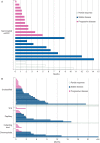Treatment outcome with mTOR inhibitors for metastatic renal cell carcinoma with nonclear and sarcomatoid histologies
- PMID: 24458473
- PMCID: PMC4229900
- DOI: 10.1093/annonc/mdt578
Treatment outcome with mTOR inhibitors for metastatic renal cell carcinoma with nonclear and sarcomatoid histologies
Abstract
Background: The clinical trials that reported benefit of the rapalogs temsirolimus and everolimus in advanced renal cell carcinoma (RCC) were primarily conducted in patients with clear-cell histology (ccRCC). We assessed outcome with these mammalian target of rapamicin (mTOR) inhibitors in two subsets of kidney cancer: sarcomatoid variant ccRCC and nonclear-cell RCC.
Patients and methods: Baseline clinical features, information on prior treatment, and histologic subtypes were collected for patients previously treated with rapalogs for metastatic RCC of either nonclear phenotype or ccRCC with sarcomatoid features. Outcome was assessed centrally by a dedicated research radiologist for determination of tumor response, progression-free survival (PFS), and overall survival (OS).
Results: Eighty-five patients received temsirolimus (n = 59) or everolimus (n = 26). Nonclear-cell phenotypes included papillary (n = 14), chromophobe (n = 9), collecting duct (n = 4), translocation-associated (n = 3), and unclassified (n = 32) RCC. Twenty-three patients had clear-cell histology with sarcomatoid features. The response rate in assessable patients (n = 82) was 7% (all partial responses); 49% of patients achieved stable disease, and 44% had progressive disease as their best response. Tumor shrinkage was observed in 26 patients (32%). Median PFS and OS were 2.9 and 8.7 months, respectively. Nine patients (11%) were treated for ≥1 year, including cases of papillary (n = 3), chromophobe (n = 2), unclassified (n = 3) RCC, and ccRCC with sarcomatoid features (n = 1). No tumor shrinkages were observed for patients with collecting duct or translocation-associated RCC.
Conclusions: A subset of patients with nonclear-cell and sarcomatoid variant ccRCC subtypes benefit from mTOR inhibitors, but most have poor outcome. Histologic subtype does not appear to be helpful in selecting patients for rapalog therapy. Future efforts should include the identification of predictive tissue biomarkers.
Keywords: mTOR inhibitors; nonclear-cell rCC; renal cell carcinoma; sarcomatoid.
Figures



References
-
- Siegel R, Naishadham D, Jemal A. Cancer statistics, 2013. CA Cancer J Clin. 2013;63:11–30. - PubMed
-
- Kovacs G, Akhtar M, Beckwith BJ, et al. The Heidelberg classification of renal cell tumours. J Pathol. 1997;183:131–133. - PubMed
-
- Reuter VE, Presti JC., Jr Contemporary approach to the classification of renal epithelial tumors. Semin Oncol. 2000;27:124–137. - PubMed
-
- Lopez-Beltran A, Scarpelli M, Montironi R, et al. 2004 WHO classification of the renal tumors of the adults. Eur Urol. 2006;49:798–805. - PubMed
-
- de Peralta-Venturina M, Moch H, Amin M, et al. Sarcomatoid differentiation in renal cell carcinoma: a study of 101 cases. Am J Surg Pathol. 2001;25:275–284. - PubMed
Publication types
MeSH terms
Substances
Grants and funding
LinkOut - more resources
Full Text Sources
Other Literature Sources
Medical
Miscellaneous

